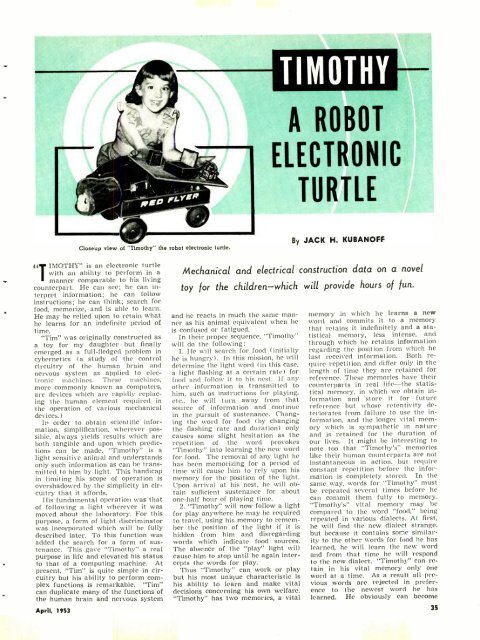T EVIS i - AmericanRadioHistory.Com
T EVIS i - AmericanRadioHistory.Com
T EVIS i - AmericanRadioHistory.Com
You also want an ePaper? Increase the reach of your titles
YUMPU automatically turns print PDFs into web optimized ePapers that Google loves.
A ROBOT<br />
ELECTRONIC<br />
TURTLE<br />
Closeup view of "Timothy" the robot electronic turtle.<br />
By JACK H. KUBANOFF<br />
"T IMOTHY" is an electronic turtle<br />
Iwith an ability to perform in a<br />
manner comparable to his living<br />
counterpart. He can see; he can interpret<br />
information; he can follow<br />
instructions; he can think; search for<br />
food, memorize, and is able to learn.<br />
He may be relied upon to retain what<br />
he learns for an indefinite period of<br />
time.<br />
"Tim" was originally constructed as<br />
a toy for my daughter but finally<br />
emerged as a full -fledged problem in<br />
cybernetics (a study of the control<br />
circuitry of the human brain and<br />
nervous system as applied to electronic<br />
machines. These machines,<br />
more commonly known as computers,<br />
are devices which are rapidly replacing<br />
the human element required in<br />
the operation of various mechanical<br />
devices.)<br />
In order to obtain scientific information,<br />
simplification, wherever possible,<br />
always yields results which are<br />
both tangible and upon which predictions<br />
can be made. "Timothy" is a<br />
light sensitive animal and understands<br />
only such information as can be transmitted<br />
to him by light. This handicap<br />
in limiting his scope of operation is<br />
overshadowed by the simplicity in circuitry<br />
that it affords.<br />
His fundamental operation was that<br />
of following a light wherever it was<br />
moved about the laboratory. For this<br />
purpose, a form of light discriminator<br />
was incorporated which will he fully<br />
described later. To this function was<br />
added the search for a form of sustenance.<br />
This gave "Timothy" a real<br />
purpose in life and elevated his status<br />
to that of a computing machine. At<br />
present, "Tim" is quite simple in circuitry<br />
but his ability to perform complex<br />
functions is remarkable. "Tim"<br />
can duplicate many of the functions of<br />
the human brain and nervous system<br />
April, 1953<br />
Mechanical and electrical construction data on a novel<br />
toy for the children -which will provide hours of fun.<br />
and he reacts in much the same manner<br />
as his animal equivalent when he<br />
is confused or fatigued.<br />
In their proper sequence, "Timothy"<br />
will do the following:<br />
1. He will search for food (initially<br />
he is hungry). In this mission, he will<br />
determine the light word (in this case,<br />
a light flashing at a certain rate) for<br />
food and follow it to his nest. If any<br />
other information is transmitted to<br />
him, such as instructions for playing,<br />
etc., he will turn away from that<br />
source of information and continue<br />
in the pursuit of sustenance. Changing<br />
the word for food (by changing<br />
the flashing rate and duration) only<br />
causes some slight hesitation as the<br />
repetition of the word provokes<br />
"Timothy" into learning the new word<br />
for food. The removal of any light he<br />
has been memorizing for a period of<br />
time will cause him to rely upon his<br />
memory for the position of the light.<br />
Upon arrival at his nest, he will obtain<br />
sufficient sustenance for about<br />
one -half hour of playing time.<br />
2. "Timothy" will now follow a light<br />
for play anywhere he may be required<br />
to travel, using his memory to remember<br />
the position of the light if it is<br />
hidden from him and disregarding<br />
words which indicate food sources.<br />
The absence of the "play" light will<br />
cause him to stop until he again intercepts<br />
the words for play.<br />
Thus "Timothy" can work or play<br />
but his most unique characteristic is<br />
his ability to learn and make vital<br />
decisions concerning his own welfare.<br />
"Timothy" has two memories, a vital<br />
memory in which he learns a new<br />
word and commits it to a memory<br />
that retains it indefinitely and a statistical<br />
memory, less intense, and<br />
through which he retains information<br />
regarding the position from which he<br />
last received information. Both require<br />
repetition and differ only in the<br />
length of time they are retained for<br />
reference. These memories have their<br />
counterparts in real life -the statistical<br />
memory, in which we obtain in-<br />
formation and store it for future<br />
reference but whose retentivity deteriorates<br />
from failure to use the information,<br />
and the longer vital memory<br />
which is sympathetic in nature<br />
and is retained for the duration of<br />
our lives. It might be interesting to<br />
note too that "Timothy's" memories<br />
like their human counterparts are not<br />
instantaneous in action, but require<br />
constant repetition before the infor-<br />
mation is completely stored. In the<br />
same way, words for "Timothy" must<br />
be repeated several times before he<br />
can commit them fully to memory.<br />
"Timothy's" vital memory may be<br />
compared to the word "food," being<br />
repeated in various dialects. At first,<br />
he will find the new dialect strange,<br />
but because it contains some similarity<br />
to the other words for food he has<br />
learned, he will learn the new word<br />
and from that time he will respond<br />
to the new dialect. "Timothy" can retain<br />
in his vital memory only one<br />
word at a time. As a result all previous<br />
words are rejected in prefer-<br />
ence to the newest word he has<br />
learned. He obviously can become<br />
35

















